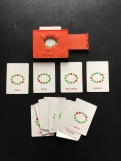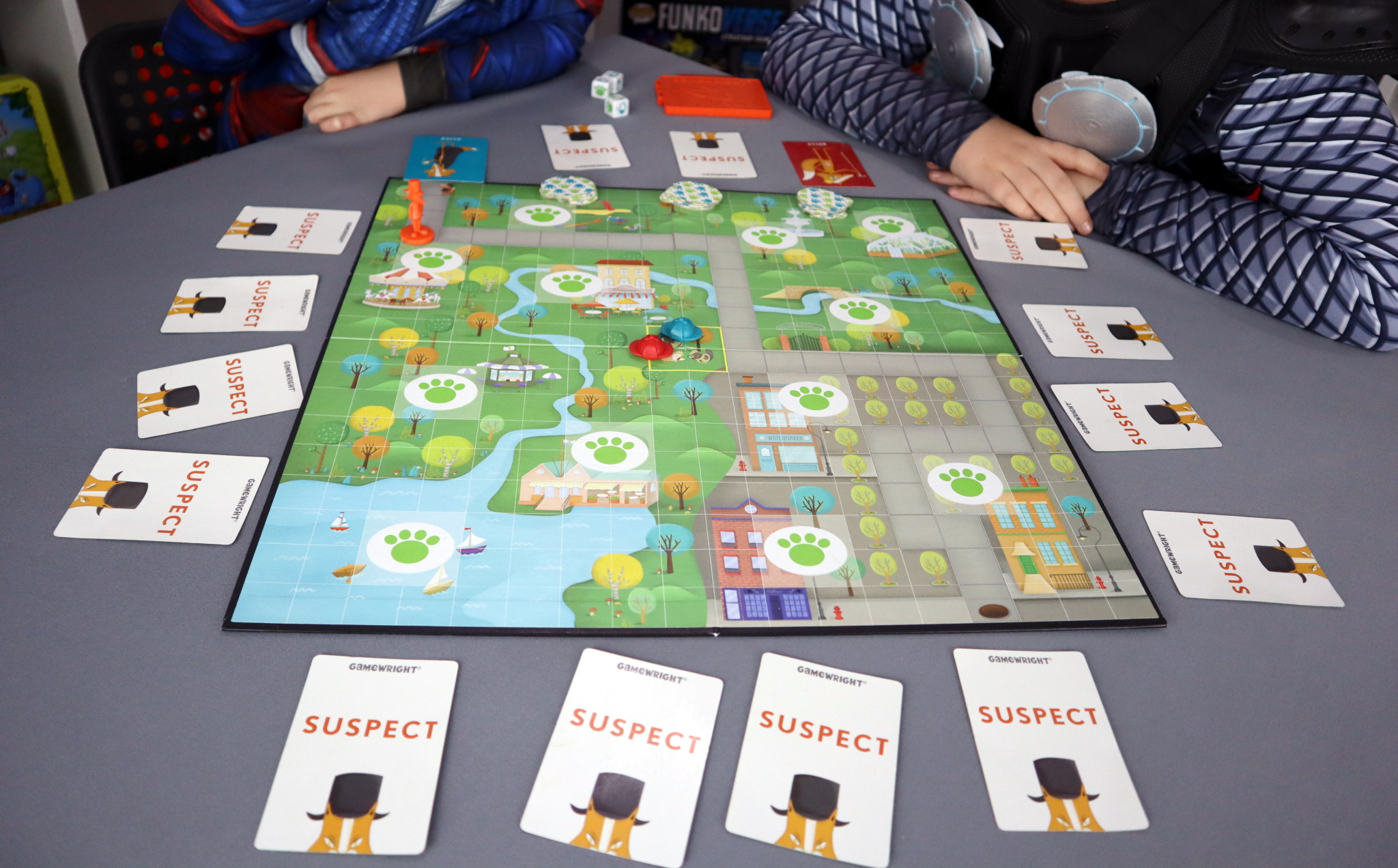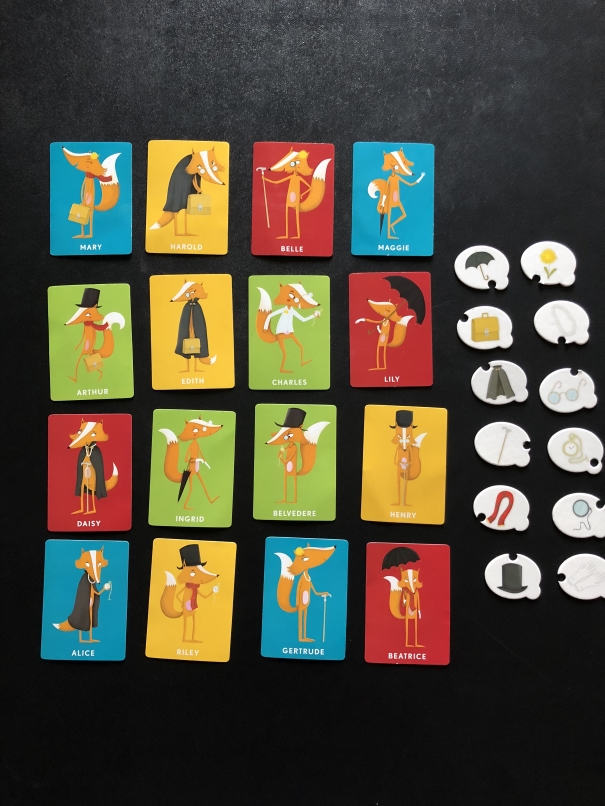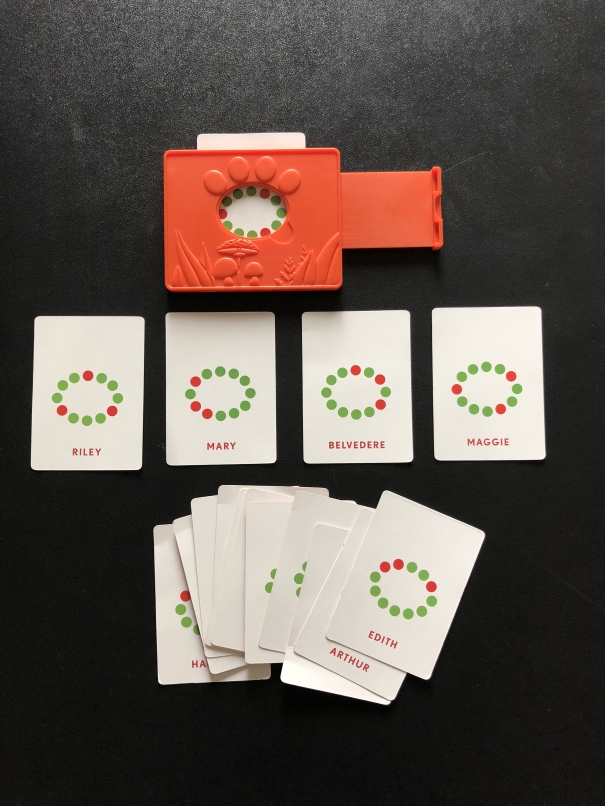
WE PLAY 2 LEARN
Game Ratings
FAMILY
8
YOUNG KIDS
9
OLDER KIDS
4
ADULTS
2
Overview
| Players | Playing Time | Best Age | Educational |
| 2 - 4 | 10-20 minutes | 3 - 10 | Deductive Reasoning Team Problem Solving Memory |
| Skill | Luck | Strategy | Social | Game Type | Play Style |
| 40% | 60% | 50% | 50% | Deduction | Cooperative |
Outfoxed! is a fun and clever game that will remind most parents of Clue. However, instead of competing against one
another, the players work together on one team to defeat the game. This is made possible through the use of a innovative but simple Clue Decoder that can reveal the answer
to one clue at a time without giving the rest away.
Outfoxed! is a great introduction to deductive reasoning and logic, requiring kids to match the clue answers with a suspect pool that is revealed over time. The team will
also need to work together to determine the best way to pursue the suspects and clues. This is one of the most unique games we've found that allows young kids to
play and contribute to the team's sucess.



How to Play
Official Rules
The official rules are available here. The rules are well explained, including helpful illustrations.
Enhanced Rules
This is not a game that will require much customization as the difficulty seems appropriate for the age and it plays quickly. However, we do have some suggestions in our Tips section for those that feel the difficulty level may be a little too hard for young kids.
FAQ
How many players?
- Playable with 2-4
- Best with 2-4
What ages can play?
- Playable for ages 3 to Adult
- Best for ages 3 to 10
Can different skill levels or ages play together?
Yes, this is a cooperative game so all players will be working together. There is also a strong element of luck to this game so young players will be able to contribute.
How long does it take to play?
10 - 20 minutes
Will we get bored after playing it a few times or does the game have good replayability?
Considering this is a game that can be played by a 3 year old, this game has good replayability. Each game will be a little different because luck is such a big factor.
Setup/Cleanup
How much work is it?
Low. There are quite a few pieces to this game, but setup and cleanup are still fairly quick.
Would kids be able to do it on their own?
Yes, but younger kids may need someone 5 or older to help handle the Clue decoder.
This is especially the case during setup so they do not inadvertently see who the thief is, but also when trying to align the clues properly in the decoder.
Will parents have fun too...
...when playing with the kids?
Parents won't find the game challenging like Clue, but it is one of the more
enjoyable cooperative games for a parent that young kids can play.
...without the kids?
No, this is not a game for adults only.
Educational Value
What skills will this game help develop?
Deductive Reasoning
This is a very good game to begin teaching the idea of deductive reasoning and logic.
Team Problem Solving
Luck plays a strong factor in this game, but the team must still use planning and coordination to find sufficient clues and suspects.
Memory
Players will need to remember which clues were revealed to be Yes and which were No. For younger kids that may struggle
with this, we suggest a simple method to help in our Custom Rules section.
But will my kids actually have fun playing it?
Yes
Tips
To make the game easier for younger kids
Don't require young kids to declare if they are rolling for Suspects or Clues
This is one change we suggest for most kids below the age of 5. The rules state you must declare what you're trying to roll for before your first roll, but we prefer not to enforce this with younger kids. We leave them free to choose after their first roll and even change between rolls. This will lead to less frustration and a more enjoyable game for them.
Turn clue tokens one direction if they revealed Yes and a different direction for No
It is common to have 5 or 6 clues revealed by the end of a game. Even for an adult it can be challenging to remember which clue was a Yes and which was a No. Placing the two answers in different
directions on the board can help with this. Upside down for No and right-side up for Yes is a simple way to do this.
To make the game more difficult
Move the fox 4 or 5 spaces when a roll is unsuccessful
This is actually an official suggestion from the game manufacturer. This is a simple change that won't affect gameplay. We have even increased the number of spaces the fox moves mid-game if a particular round seems to be too easy.
Do you use custom rules we haven't thought of? If you have found some other ways to customize the rules, please share them with us through our Contact page. We're always interested in new ways to improve gameplay.
Where to Buy
Similar Games
If you like this game, we suggest these others
Or check out our full list of Reviews where you can sort by any of these categories
We are a participant in the Amazon Services LLC Associates Program, an affiliate advertising program designed to provide a means for us to earn fees by linking to Amazon.com and affiliated sites



